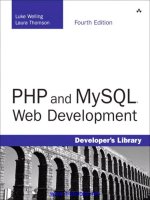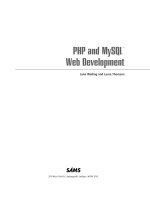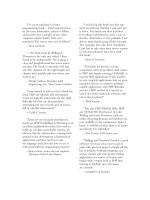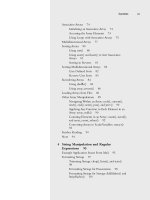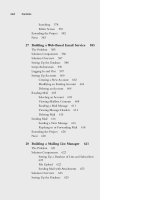PHP and MySQL Web Development - P12 pot
Bạn đang xem bản rút gọn của tài liệu. Xem và tải ngay bản đầy đủ của tài liệu tại đây (76.53 KB, 5 trang )
22
Chapter 1 PHP Crash Course
Let’s look at an example.
Because the long style variable names are somewhat cumbersome, and rely on a vari-
able type known as arrays, which we will not cover properly until Chapter 3,“Using
Arrays,” we will start by creating easier-to-use copies.
To copy the value of one variable into another, you use the assignment operator,
which in PHP is an equal sign (=).The following line of code will create a new variable
named $tireqty and copy the contents of $HTTP_POST_VARS['tireqty'] into the new
variable:
$tireqty = $HTTP_POST_VARS['tireqty'];
Place the following block of code at the start of the processing script. All other scripts in
this book that handle data from a form will contain a similar block at the start. As it will
not produce any output, it makes no difference whether you place this above or below
the <html> and other HTML tags that start your page.We are generally placing this
block at the very start of the script to make it easy to find.
<?php
//create short variable names
$tireqty = $HTTP_POST_VARS['tireqty'];
$oilqty = $HTTP_POST_VARS['oilqty'];
$sparkqty = $HTTP_POST_VARS['sparkqty'];
?>
This code is creating three new variables, $tireqty, $oilqty,and $sparkqty, and set-
ting them to contain the data that was sent via the POST method from the form.
To make the script start doing something visible, add the following lines to the bottom
of your PHP script:
echo '<p>Your order is as follows: </p>';
echo $tireqty.' tires<br />';
echo $oilqty.' bottles of oil<br />';
echo $sparkqty.' spark plugs<br />';
If you now load this file in your browser, the script output should resemble what is
shown in Figure 1.4.The actual values shown will, of course, depend on what you typed
into the form.
A couple of interesting things to note in this example are discussed in the following
subsections.
String Concatenation
In the script, we used echo to print the value the user typed in each of the form fields,
followed by some explanatory text. If you look closely at the echo statements, you will
see that the variable name and following text have a period (.) between them, such as
this:
echo $tireqty.' tires<br />';
03 525x ch01 1/24/03 3:40 PM Page 22
23
Accessing Form Variables
Figure 1.4 The form variables typed in by the user are
easily accessible in processorder.php.
This is the string concatenation operator and is used to add strings (pieces of text)
together.You will often use it when sending output to the browser with echo.This is
used to avoid having to write multiple echo commands.
For any non-array variables you can also place the variable inside a double-quoted
string to be echoed. (Arrays are a little more complicated so we will look at combining
arrays and strings in Chapter 4,“String Manipulation and Regular Expressions.”)
For example:
echo
"
$tireqty tires<br />";
This is equivalent to the first statement. Either format is valid, and which one you use is
a matter of personal taste. Note that this is only a feature of double-quoted strings.You
cannot place variable names inside a single-quoted string in this way. Running the fol-
lowing line of code
echo '$tireqty tires<br />';
will send "$tireqty tires<br />" to the browser.Within double quotes, the variable
name will be replaced with its value.Within single quotes, the variable name, or any
other text will be sent unaltered.
Va riables and Literals
The variable and string we concatenate together in each of the echo statements are dif-
ferent types of things.Variables are a symbol for data.The strings are data themselves.
When we use a piece of raw data in a program like this, we call it a literal to distinguish
it from a variable. $tireqty is a variable, a symbol which represents the data the cus-
tomer typed in. On the other hand, ' tires<br />' is a literal. It can be taken at face
value.
03 525x ch01 1/24/03 3:40 PM Page 23
24
Chapter 1 PHP Crash Course
Well, almost. Remember the second example previously? PHP replaced the variable
name $tireqty in the string with the value stored in the variable.
Remember there are two kinds of strings in PHP—ones with double quotes and
ones with single quotes. PHP will try and evaluate strings in double quotes, resulting in
the behavior we saw earlier. Single quoted strings will be treated as true literals.
Identifiers
Identifiers are the names of variables. (The names of functions and classes are also identi-
fiers—we’ll look at functions and classes in Chapters 5,“Reusing Code and Writing
Functions,” and 6,“Object-Oriented PHP.”) There are some simple rules about identi-
fiers:
n
Identifiers can be of any length and can consist of letters, numbers, underscores,
and dollar signs. However, you should be careful when using dollar signs in identi-
fiers.You’ll see why in the section called,“Variable Variables.”
n
Identifiers cannot begin with a digit.
n
In PHP, identifiers are case sensitive. $tireqty is not the same as $TireQty.Trying
to use these interchangeably is a common programming error. Function names are
an exception to this rule—their names can be used in any case.
n
A variable can have the same name as a function.This is confusing however, and
should be avoided.Also, you cannot create a function with the same name as
another function.
User Declared Variables
You can declare and use your own variables in addition to the variables you are passed
from the HTML form.
One of the features of PHP is that it does not require you to declare variables before
using them. A variable will be created when you first assign a value to it—see the next
section for details.
Assigning Values to Variables
You assign values to variables using the assignment operator, =, as we did when copying
one variable’s value to another. On Bob’s site, we want to work out the total number of
items ordered and the total amount payable.We can create two variables to store these
numbers.To begin with, we’ll initialize each of these variables to zero.
Add these lines to the bottom of your PHP script:
$totalqty = 0;
$totalamount = 0.00;
03 525x ch01 1/24/03 3:40 PM Page 24
25
Variable Types
Each of these two lines creates a variable and assigns a literal value to it.You can also
assign variable values to variables, for example:
$totalqty = 0;
$totalamount = $totalqty;
Va riable Types
A variable’s type refers to the kind of data that is stored in it.
PHP’s Data Types
PHP supports the following data types:
n
Integer—Used for whole numbers
n
Double—Used for real numbers
n
String—Used for strings of characters
n
Boolean—Used for true or false values
n
Array—Used to store multiple data items of the same type (see Chapter 3)
n
Object—Used for storing instances of classes (see Chapter 6)
PHP 4 added three extra types—Boolean, NULL, and resource.Variables that have not
been given a value, have been unset, or have been given the specific value NULL are of
type NULL. Certain built-in functions (such as database functions) return variables that
have the type resource.You will almost certainly not directly manipulate a resource vari-
able.
PHP also supports the pdfdoc and pdfinfo types if it has been installed with PDF
(Portable Document Format) support.We will discuss using PDF in PHP in Chapter 30,
“Generating Personalized Documents in Portable Document Format (PDF).”
Type Strength
PHP is a very weakly typed language. In most programming languages, variables can
only hold one type of data, and that type must be declared before the variable can be
used, as in C. In PHP, the type of a variable is determined by the value assigned to it.
For example, when we created
$totalqty and $totalamount, their initial types were
determined, as follows:
$totalqty = 0;
$totalamount = 0.00;
Because we assigned 0, an integer, to $totalqty,this is now an integer type variable.
Similarly, $totalamount is now of type double.
Strangely enough, we could now add a line to our script as follows:
$totalamount = 'Hello';
03 525x ch01 1/24/03 3:40 PM Page 25
26
Chapter 1 PHP Crash Course
The variable $totalamount would then be of type string. PHP changes the variable type
according to what is stored in it at any given time.
This ability to change types transparently on-the-fly can be extremely useful.
Remember PHP “automagically” knows what data type you put into your variable. It
will return the data with the same data type once you retrieve it from the variable.
Type Casting
You can pretend that a variable or value is of a different type by using a type cast.These
work identically to the way they work in C.You simply put the temporary type in
brackets in front of the variable you want to cast.
For example, we could have declared the two variables above using a cast.
$totalqty = 0;
$totalamount = (double)$totalqty;
The second line means “Take the value stored in $totalqty, interpret it as a double, and
store it in $totalamount.” The $totalamount variable will be of type double.The cast
variable does not change types, so $totalqty remains of type integer.
Va riable Variables
PHP provides one other type of variable—the variable variable.Variable variables enable
us to change the name of a variable dynamically.
(As you can see, PHP allows a lot of freedom in this area—all languages will let you
change the value of a variable, but not many will allow you to change the variable’s type,
and even fewer will let you change the variable’s name.)
The way these work is to use the value of one variable as the name of another. For
example, we could set
$varname = 'tireqty';
We can then use $$varname in place of $tireqty.For example, we can set the value of
$tireqty:
$$varname = 5;
This is exactly equivalent to
$tireqty = 5;
This might seem a little obscure, but we’ll revisit its use later. Instead of having to list
and use each form variable separately, we can use a loop and a variable to process them
all automatically.There’s an example illustrating this in the section on for loops.
Constants
As you saw previously, we can change the value stored in a variable.We can also declare
constants. A constant stores a value such as a variable, but its value is set once and then
cannot be changed elsewhere in the script.
03 525x ch01 1/24/03 3:40 PM Page 26

